Charles Sturt University: MKT510 Consumer Behavior Discussion Posts
VerifiedAdded on 2022/08/21
|11
|2603
|16
Discussion Board Post
AI Summary
This discussion post, written for a Consumer Behavior course (MKT510) at Charles Sturt University, analyzes two key aspects of consumer behavior: situational and cultural influences. The first post examines situational influences, using a Seven Eleven Slurpee advertisement as an example, focusing on how factors like time and physical surroundings impact consumer purchasing decisions. The second post delves into cultural influences, highlighting the importance of understanding cultural nuances, particularly in the context of Halal food and the adaptability of companies like McDonald's and Nokia to cater to diverse cultural preferences. The post discusses how companies can identify consumer needs based on cultural factors and adapt product offerings and marketing strategies accordingly. The assignment emphasizes the dynamic nature of consumer behavior and the need for companies to adapt their strategies to stay relevant. The author provides meaningful and insightful responses to the discussion questions, integrating theory and suggesting further applications of the concepts.
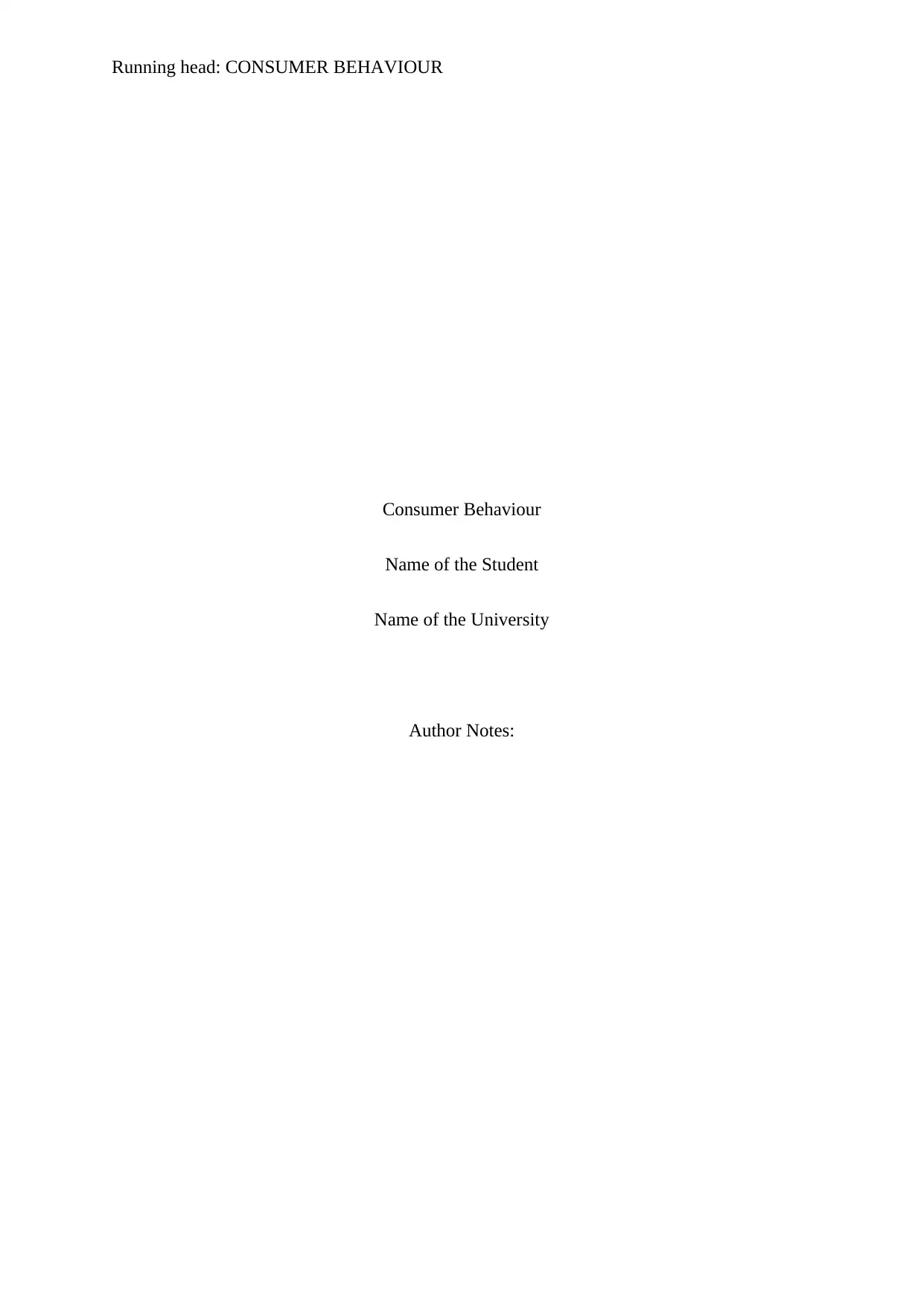
Running head: CONSUMER BEHAVIOUR
Consumer Behaviour
Name of the Student
Name of the University
Author Notes:
Consumer Behaviour
Name of the Student
Name of the University
Author Notes:
Paraphrase This Document
Need a fresh take? Get an instant paraphrase of this document with our AI Paraphraser
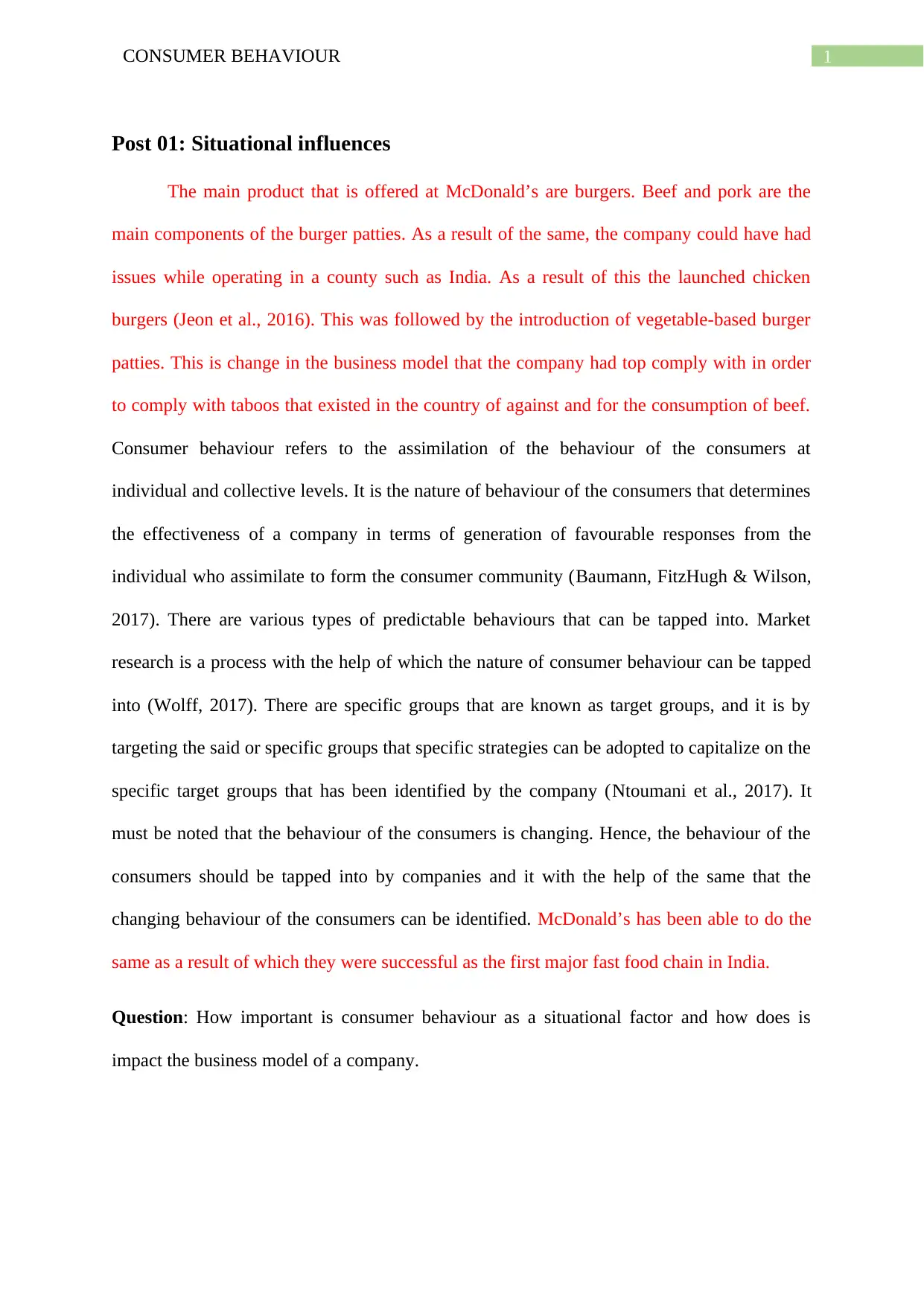
1CONSUMER BEHAVIOUR
Post 01: Situational influences
The main product that is offered at McDonald’s are burgers. Beef and pork are the
main components of the burger patties. As a result of the same, the company could have had
issues while operating in a county such as India. As a result of this the launched chicken
burgers (Jeon et al., 2016). This was followed by the introduction of vegetable-based burger
patties. This is change in the business model that the company had top comply with in order
to comply with taboos that existed in the country of against and for the consumption of beef.
Consumer behaviour refers to the assimilation of the behaviour of the consumers at
individual and collective levels. It is the nature of behaviour of the consumers that determines
the effectiveness of a company in terms of generation of favourable responses from the
individual who assimilate to form the consumer community (Baumann, FitzHugh & Wilson,
2017). There are various types of predictable behaviours that can be tapped into. Market
research is a process with the help of which the nature of consumer behaviour can be tapped
into (Wolff, 2017). There are specific groups that are known as target groups, and it is by
targeting the said or specific groups that specific strategies can be adopted to capitalize on the
specific target groups that has been identified by the company (Ntoumani et al., 2017). It
must be noted that the behaviour of the consumers is changing. Hence, the behaviour of the
consumers should be tapped into by companies and it with the help of the same that the
changing behaviour of the consumers can be identified. McDonald’s has been able to do the
same as a result of which they were successful as the first major fast food chain in India.
Question: How important is consumer behaviour as a situational factor and how does is
impact the business model of a company.
Post 01: Situational influences
The main product that is offered at McDonald’s are burgers. Beef and pork are the
main components of the burger patties. As a result of the same, the company could have had
issues while operating in a county such as India. As a result of this the launched chicken
burgers (Jeon et al., 2016). This was followed by the introduction of vegetable-based burger
patties. This is change in the business model that the company had top comply with in order
to comply with taboos that existed in the country of against and for the consumption of beef.
Consumer behaviour refers to the assimilation of the behaviour of the consumers at
individual and collective levels. It is the nature of behaviour of the consumers that determines
the effectiveness of a company in terms of generation of favourable responses from the
individual who assimilate to form the consumer community (Baumann, FitzHugh & Wilson,
2017). There are various types of predictable behaviours that can be tapped into. Market
research is a process with the help of which the nature of consumer behaviour can be tapped
into (Wolff, 2017). There are specific groups that are known as target groups, and it is by
targeting the said or specific groups that specific strategies can be adopted to capitalize on the
specific target groups that has been identified by the company (Ntoumani et al., 2017). It
must be noted that the behaviour of the consumers is changing. Hence, the behaviour of the
consumers should be tapped into by companies and it with the help of the same that the
changing behaviour of the consumers can be identified. McDonald’s has been able to do the
same as a result of which they were successful as the first major fast food chain in India.
Question: How important is consumer behaviour as a situational factor and how does is
impact the business model of a company.
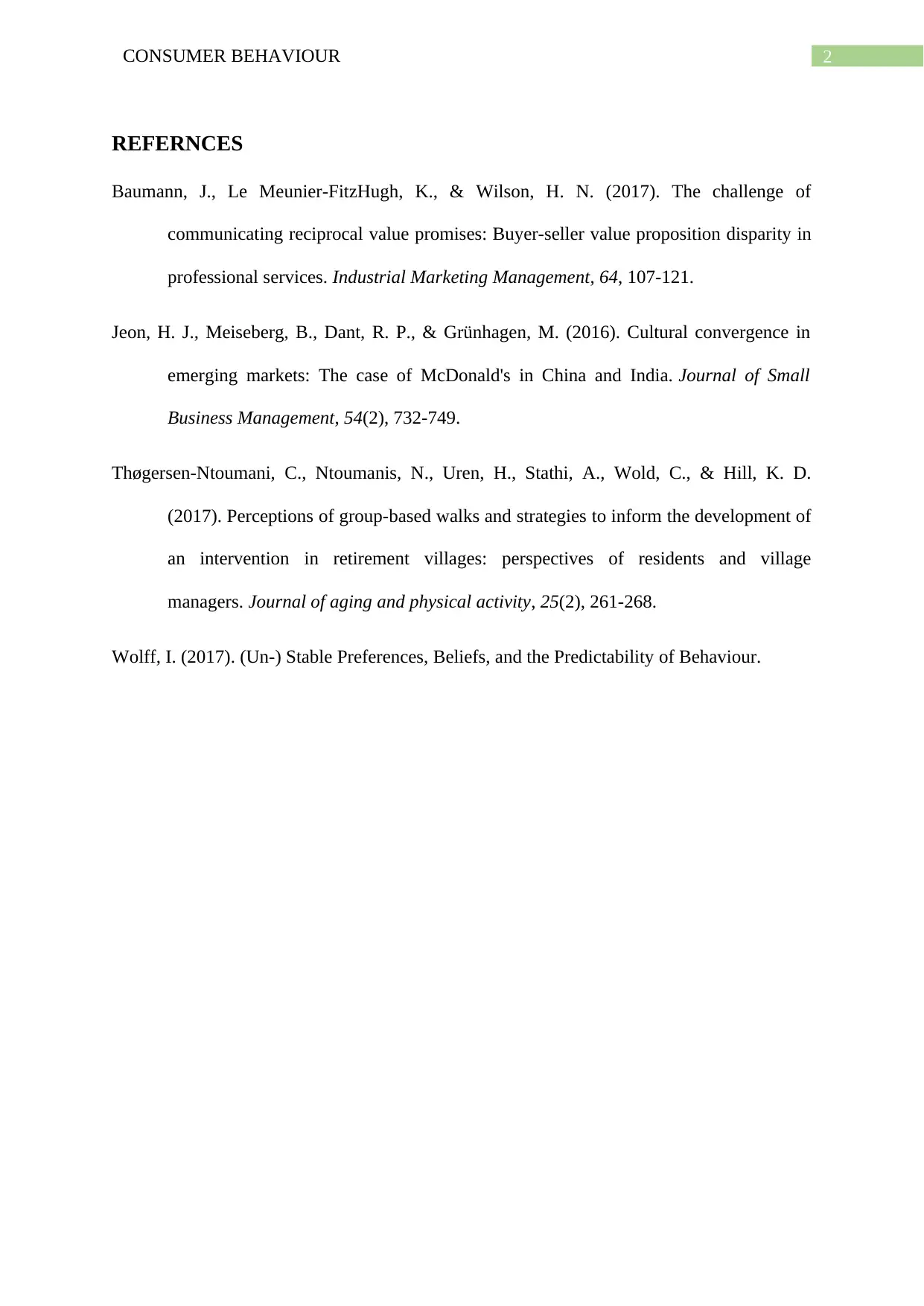
2CONSUMER BEHAVIOUR
REFERNCES
Baumann, J., Le Meunier-FitzHugh, K., & Wilson, H. N. (2017). The challenge of
communicating reciprocal value promises: Buyer-seller value proposition disparity in
professional services. Industrial Marketing Management, 64, 107-121.
Jeon, H. J., Meiseberg, B., Dant, R. P., & Grünhagen, M. (2016). Cultural convergence in
emerging markets: The case of McDonald's in China and India. Journal of Small
Business Management, 54(2), 732-749.
Thøgersen-Ntoumani, C., Ntoumanis, N., Uren, H., Stathi, A., Wold, C., & Hill, K. D.
(2017). Perceptions of group-based walks and strategies to inform the development of
an intervention in retirement villages: perspectives of residents and village
managers. Journal of aging and physical activity, 25(2), 261-268.
Wolff, I. (2017). (Un-) Stable Preferences, Beliefs, and the Predictability of Behaviour.
REFERNCES
Baumann, J., Le Meunier-FitzHugh, K., & Wilson, H. N. (2017). The challenge of
communicating reciprocal value promises: Buyer-seller value proposition disparity in
professional services. Industrial Marketing Management, 64, 107-121.
Jeon, H. J., Meiseberg, B., Dant, R. P., & Grünhagen, M. (2016). Cultural convergence in
emerging markets: The case of McDonald's in China and India. Journal of Small
Business Management, 54(2), 732-749.
Thøgersen-Ntoumani, C., Ntoumanis, N., Uren, H., Stathi, A., Wold, C., & Hill, K. D.
(2017). Perceptions of group-based walks and strategies to inform the development of
an intervention in retirement villages: perspectives of residents and village
managers. Journal of aging and physical activity, 25(2), 261-268.
Wolff, I. (2017). (Un-) Stable Preferences, Beliefs, and the Predictability of Behaviour.
⊘ This is a preview!⊘
Do you want full access?
Subscribe today to unlock all pages.

Trusted by 1+ million students worldwide
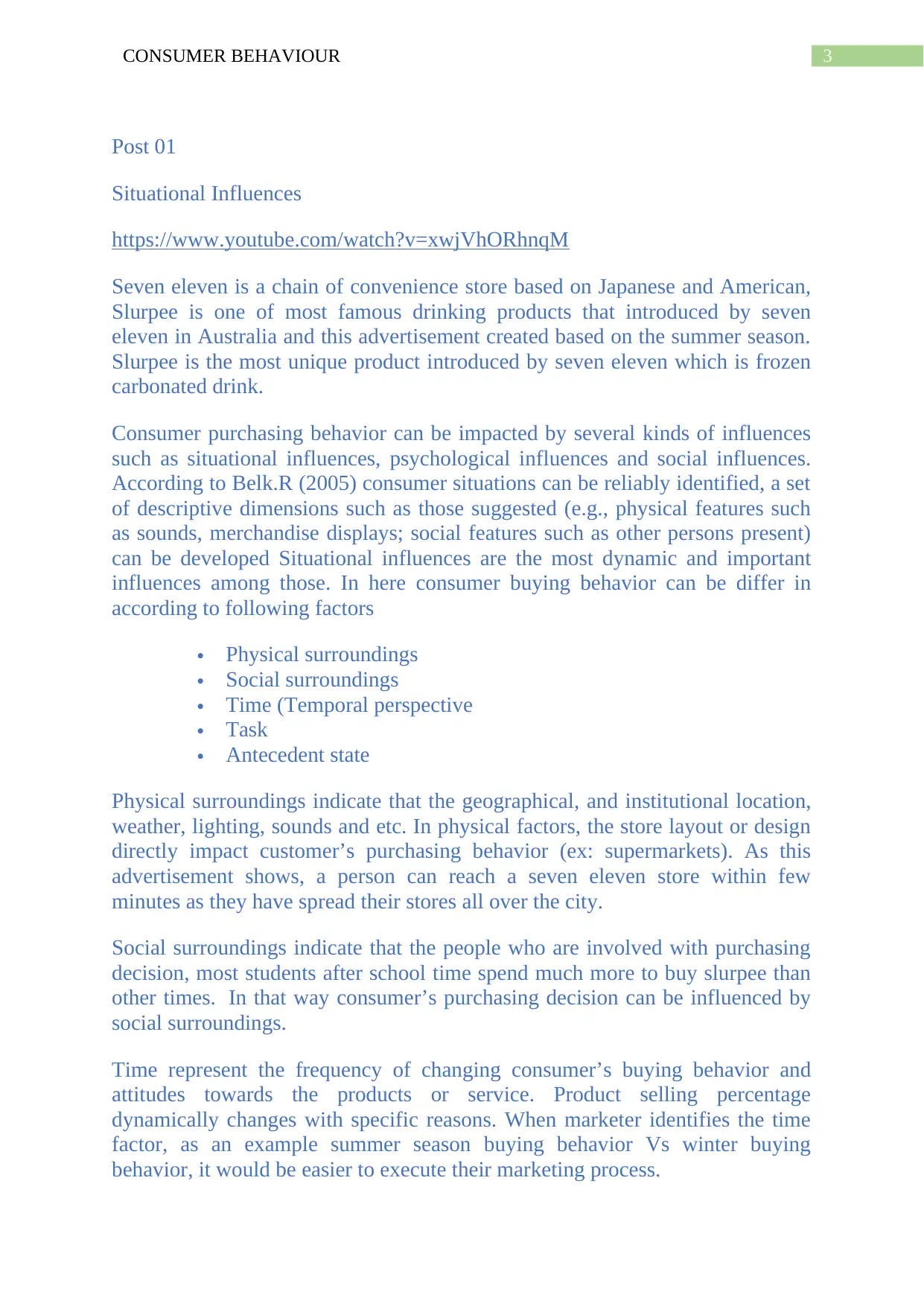
3CONSUMER BEHAVIOUR
Post 01
Situational Influences
https://www.youtube.com/watch?v=xwjVhORhnqM
Seven eleven is a chain of convenience store based on Japanese and American,
Slurpee is one of most famous drinking products that introduced by seven
eleven in Australia and this advertisement created based on the summer season.
Slurpee is the most unique product introduced by seven eleven which is frozen
carbonated drink.
Consumer purchasing behavior can be impacted by several kinds of influences
such as situational influences, psychological influences and social influences.
According to Belk.R (2005) consumer situations can be reliably identified, a set
of descriptive dimensions such as those suggested (e.g., physical features such
as sounds, merchandise displays; social features such as other persons present)
can be developed Situational influences are the most dynamic and important
influences among those. In here consumer buying behavior can be differ in
according to following factors
Physical surroundings
Social surroundings
Time (Temporal perspective
Task
Antecedent state
Physical surroundings indicate that the geographical, and institutional location,
weather, lighting, sounds and etc. In physical factors, the store layout or design
directly impact customer’s purchasing behavior (ex: supermarkets). As this
advertisement shows, a person can reach a seven eleven store within few
minutes as they have spread their stores all over the city.
Social surroundings indicate that the people who are involved with purchasing
decision, most students after school time spend much more to buy slurpee than
other times. In that way consumer’s purchasing decision can be influenced by
social surroundings.
Time represent the frequency of changing consumer’s buying behavior and
attitudes towards the products or service. Product selling percentage
dynamically changes with specific reasons. When marketer identifies the time
factor, as an example summer season buying behavior Vs winter buying
behavior, it would be easier to execute their marketing process.
Post 01
Situational Influences
https://www.youtube.com/watch?v=xwjVhORhnqM
Seven eleven is a chain of convenience store based on Japanese and American,
Slurpee is one of most famous drinking products that introduced by seven
eleven in Australia and this advertisement created based on the summer season.
Slurpee is the most unique product introduced by seven eleven which is frozen
carbonated drink.
Consumer purchasing behavior can be impacted by several kinds of influences
such as situational influences, psychological influences and social influences.
According to Belk.R (2005) consumer situations can be reliably identified, a set
of descriptive dimensions such as those suggested (e.g., physical features such
as sounds, merchandise displays; social features such as other persons present)
can be developed Situational influences are the most dynamic and important
influences among those. In here consumer buying behavior can be differ in
according to following factors
Physical surroundings
Social surroundings
Time (Temporal perspective
Task
Antecedent state
Physical surroundings indicate that the geographical, and institutional location,
weather, lighting, sounds and etc. In physical factors, the store layout or design
directly impact customer’s purchasing behavior (ex: supermarkets). As this
advertisement shows, a person can reach a seven eleven store within few
minutes as they have spread their stores all over the city.
Social surroundings indicate that the people who are involved with purchasing
decision, most students after school time spend much more to buy slurpee than
other times. In that way consumer’s purchasing decision can be influenced by
social surroundings.
Time represent the frequency of changing consumer’s buying behavior and
attitudes towards the products or service. Product selling percentage
dynamically changes with specific reasons. When marketer identifies the time
factor, as an example summer season buying behavior Vs winter buying
behavior, it would be easier to execute their marketing process.
Paraphrase This Document
Need a fresh take? Get an instant paraphrase of this document with our AI Paraphraser
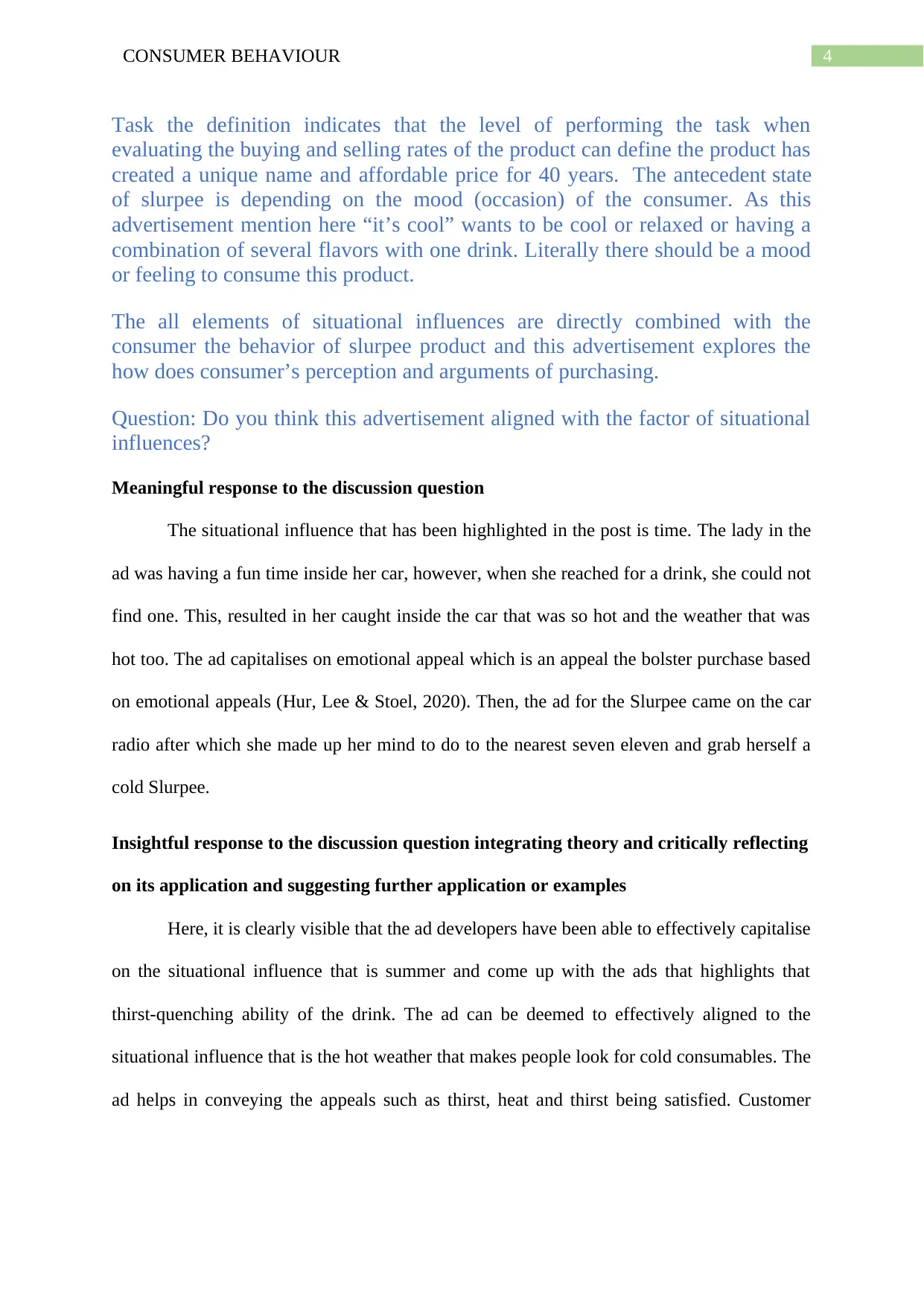
4CONSUMER BEHAVIOUR
Task the definition indicates that the level of performing the task when
evaluating the buying and selling rates of the product can define the product has
created a unique name and affordable price for 40 years. The antecedent state
of slurpee is depending on the mood (occasion) of the consumer. As this
advertisement mention here “it’s cool” wants to be cool or relaxed or having a
combination of several flavors with one drink. Literally there should be a mood
or feeling to consume this product.
The all elements of situational influences are directly combined with the
consumer the behavior of slurpee product and this advertisement explores the
how does consumer’s perception and arguments of purchasing.
Question: Do you think this advertisement aligned with the factor of situational
influences?
Meaningful response to the discussion question
The situational influence that has been highlighted in the post is time. The lady in the
ad was having a fun time inside her car, however, when she reached for a drink, she could not
find one. This, resulted in her caught inside the car that was so hot and the weather that was
hot too. The ad capitalises on emotional appeal which is an appeal the bolster purchase based
on emotional appeals (Hur, Lee & Stoel, 2020). Then, the ad for the Slurpee came on the car
radio after which she made up her mind to do to the nearest seven eleven and grab herself a
cold Slurpee.
Insightful response to the discussion question integrating theory and critically reflecting
on its application and suggesting further application or examples
Here, it is clearly visible that the ad developers have been able to effectively capitalise
on the situational influence that is summer and come up with the ads that highlights that
thirst-quenching ability of the drink. The ad can be deemed to effectively aligned to the
situational influence that is the hot weather that makes people look for cold consumables. The
ad helps in conveying the appeals such as thirst, heat and thirst being satisfied. Customer
Task the definition indicates that the level of performing the task when
evaluating the buying and selling rates of the product can define the product has
created a unique name and affordable price for 40 years. The antecedent state
of slurpee is depending on the mood (occasion) of the consumer. As this
advertisement mention here “it’s cool” wants to be cool or relaxed or having a
combination of several flavors with one drink. Literally there should be a mood
or feeling to consume this product.
The all elements of situational influences are directly combined with the
consumer the behavior of slurpee product and this advertisement explores the
how does consumer’s perception and arguments of purchasing.
Question: Do you think this advertisement aligned with the factor of situational
influences?
Meaningful response to the discussion question
The situational influence that has been highlighted in the post is time. The lady in the
ad was having a fun time inside her car, however, when she reached for a drink, she could not
find one. This, resulted in her caught inside the car that was so hot and the weather that was
hot too. The ad capitalises on emotional appeal which is an appeal the bolster purchase based
on emotional appeals (Hur, Lee & Stoel, 2020). Then, the ad for the Slurpee came on the car
radio after which she made up her mind to do to the nearest seven eleven and grab herself a
cold Slurpee.
Insightful response to the discussion question integrating theory and critically reflecting
on its application and suggesting further application or examples
Here, it is clearly visible that the ad developers have been able to effectively capitalise
on the situational influence that is summer and come up with the ads that highlights that
thirst-quenching ability of the drink. The ad can be deemed to effectively aligned to the
situational influence that is the hot weather that makes people look for cold consumables. The
ad helps in conveying the appeals such as thirst, heat and thirst being satisfied. Customer
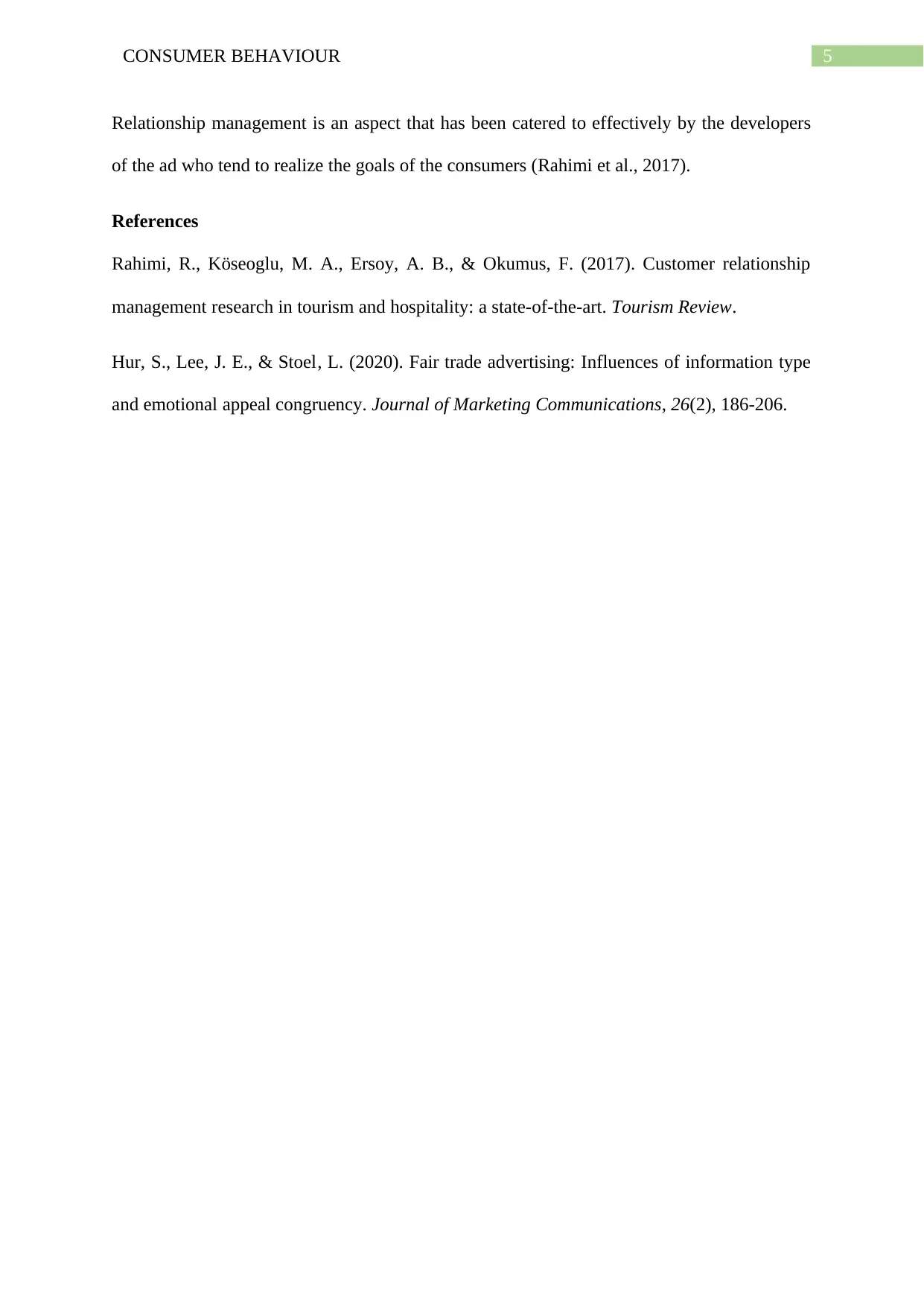
5CONSUMER BEHAVIOUR
Relationship management is an aspect that has been catered to effectively by the developers
of the ad who tend to realize the goals of the consumers (Rahimi et al., 2017).
References
Rahimi, R., Köseoglu, M. A., Ersoy, A. B., & Okumus, F. (2017). Customer relationship
management research in tourism and hospitality: a state-of-the-art. Tourism Review.
Hur, S., Lee, J. E., & Stoel, L. (2020). Fair trade advertising: Influences of information type
and emotional appeal congruency. Journal of Marketing Communications, 26(2), 186-206.
Relationship management is an aspect that has been catered to effectively by the developers
of the ad who tend to realize the goals of the consumers (Rahimi et al., 2017).
References
Rahimi, R., Köseoglu, M. A., Ersoy, A. B., & Okumus, F. (2017). Customer relationship
management research in tourism and hospitality: a state-of-the-art. Tourism Review.
Hur, S., Lee, J. E., & Stoel, L. (2020). Fair trade advertising: Influences of information type
and emotional appeal congruency. Journal of Marketing Communications, 26(2), 186-206.
⊘ This is a preview!⊘
Do you want full access?
Subscribe today to unlock all pages.

Trusted by 1+ million students worldwide
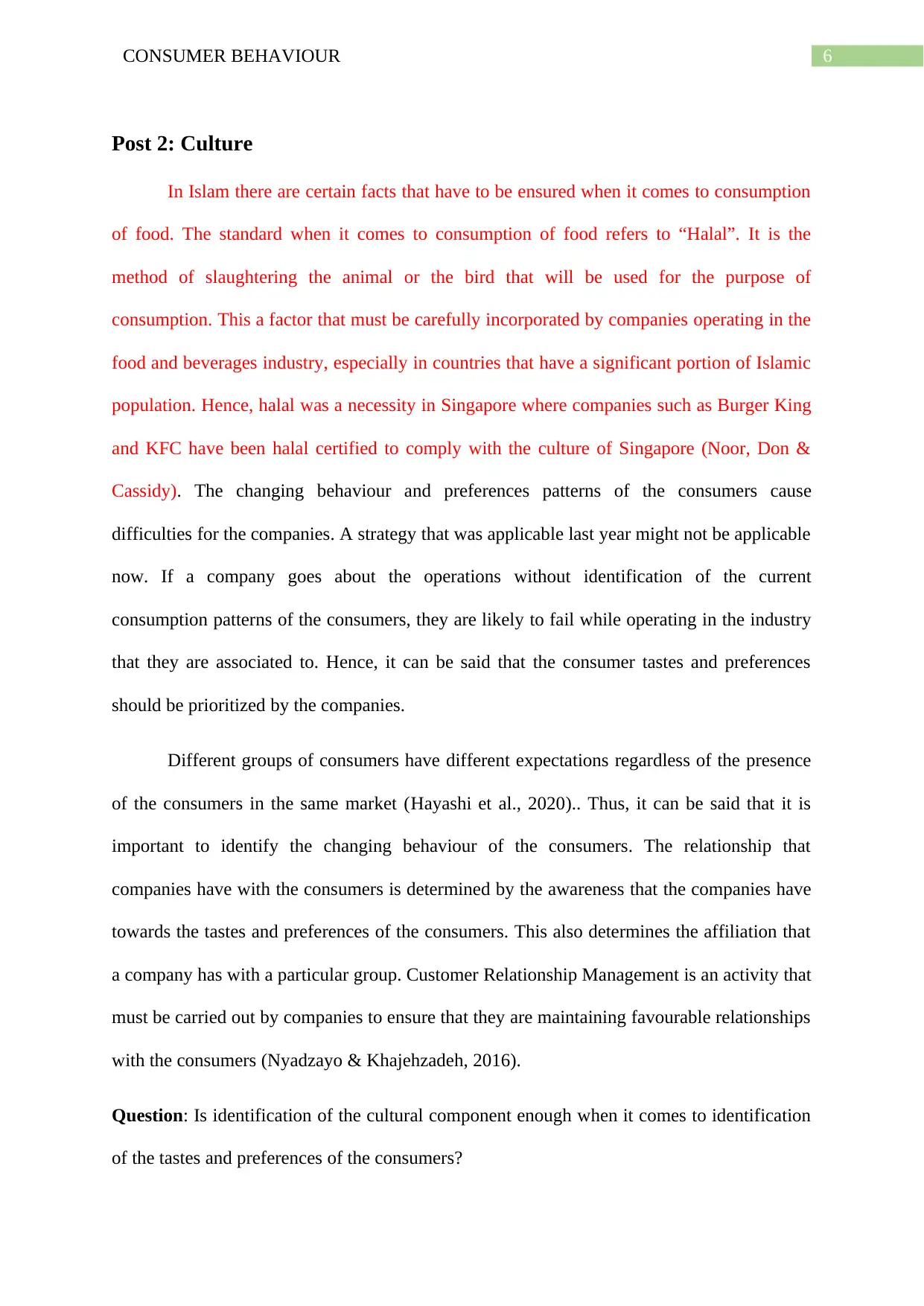
6CONSUMER BEHAVIOUR
Post 2: Culture
In Islam there are certain facts that have to be ensured when it comes to consumption
of food. The standard when it comes to consumption of food refers to “Halal”. It is the
method of slaughtering the animal or the bird that will be used for the purpose of
consumption. This a factor that must be carefully incorporated by companies operating in the
food and beverages industry, especially in countries that have a significant portion of Islamic
population. Hence, halal was a necessity in Singapore where companies such as Burger King
and KFC have been halal certified to comply with the culture of Singapore (Noor, Don &
Cassidy). The changing behaviour and preferences patterns of the consumers cause
difficulties for the companies. A strategy that was applicable last year might not be applicable
now. If a company goes about the operations without identification of the current
consumption patterns of the consumers, they are likely to fail while operating in the industry
that they are associated to. Hence, it can be said that the consumer tastes and preferences
should be prioritized by the companies.
Different groups of consumers have different expectations regardless of the presence
of the consumers in the same market (Hayashi et al., 2020).. Thus, it can be said that it is
important to identify the changing behaviour of the consumers. The relationship that
companies have with the consumers is determined by the awareness that the companies have
towards the tastes and preferences of the consumers. This also determines the affiliation that
a company has with a particular group. Customer Relationship Management is an activity that
must be carried out by companies to ensure that they are maintaining favourable relationships
with the consumers (Nyadzayo & Khajehzadeh, 2016).
Question: Is identification of the cultural component enough when it comes to identification
of the tastes and preferences of the consumers?
Post 2: Culture
In Islam there are certain facts that have to be ensured when it comes to consumption
of food. The standard when it comes to consumption of food refers to “Halal”. It is the
method of slaughtering the animal or the bird that will be used for the purpose of
consumption. This a factor that must be carefully incorporated by companies operating in the
food and beverages industry, especially in countries that have a significant portion of Islamic
population. Hence, halal was a necessity in Singapore where companies such as Burger King
and KFC have been halal certified to comply with the culture of Singapore (Noor, Don &
Cassidy). The changing behaviour and preferences patterns of the consumers cause
difficulties for the companies. A strategy that was applicable last year might not be applicable
now. If a company goes about the operations without identification of the current
consumption patterns of the consumers, they are likely to fail while operating in the industry
that they are associated to. Hence, it can be said that the consumer tastes and preferences
should be prioritized by the companies.
Different groups of consumers have different expectations regardless of the presence
of the consumers in the same market (Hayashi et al., 2020).. Thus, it can be said that it is
important to identify the changing behaviour of the consumers. The relationship that
companies have with the consumers is determined by the awareness that the companies have
towards the tastes and preferences of the consumers. This also determines the affiliation that
a company has with a particular group. Customer Relationship Management is an activity that
must be carried out by companies to ensure that they are maintaining favourable relationships
with the consumers (Nyadzayo & Khajehzadeh, 2016).
Question: Is identification of the cultural component enough when it comes to identification
of the tastes and preferences of the consumers?
Paraphrase This Document
Need a fresh take? Get an instant paraphrase of this document with our AI Paraphraser
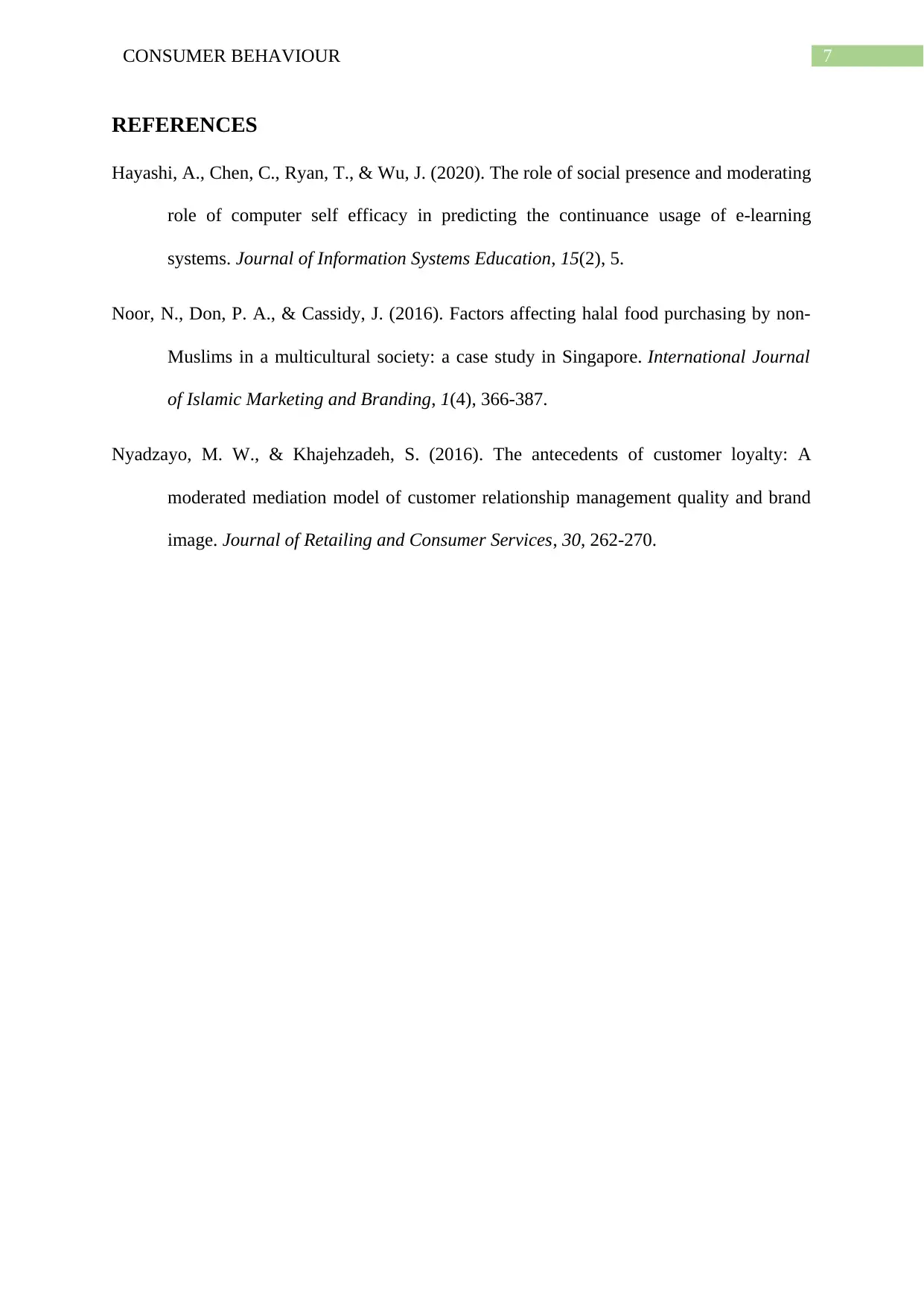
7CONSUMER BEHAVIOUR
REFERENCES
Hayashi, A., Chen, C., Ryan, T., & Wu, J. (2020). The role of social presence and moderating
role of computer self efficacy in predicting the continuance usage of e-learning
systems. Journal of Information Systems Education, 15(2), 5.
Noor, N., Don, P. A., & Cassidy, J. (2016). Factors affecting halal food purchasing by non-
Muslims in a multicultural society: a case study in Singapore. International Journal
of Islamic Marketing and Branding, 1(4), 366-387.
Nyadzayo, M. W., & Khajehzadeh, S. (2016). The antecedents of customer loyalty: A
moderated mediation model of customer relationship management quality and brand
image. Journal of Retailing and Consumer Services, 30, 262-270.
REFERENCES
Hayashi, A., Chen, C., Ryan, T., & Wu, J. (2020). The role of social presence and moderating
role of computer self efficacy in predicting the continuance usage of e-learning
systems. Journal of Information Systems Education, 15(2), 5.
Noor, N., Don, P. A., & Cassidy, J. (2016). Factors affecting halal food purchasing by non-
Muslims in a multicultural society: a case study in Singapore. International Journal
of Islamic Marketing and Branding, 1(4), 366-387.
Nyadzayo, M. W., & Khajehzadeh, S. (2016). The antecedents of customer loyalty: A
moderated mediation model of customer relationship management quality and brand
image. Journal of Retailing and Consumer Services, 30, 262-270.
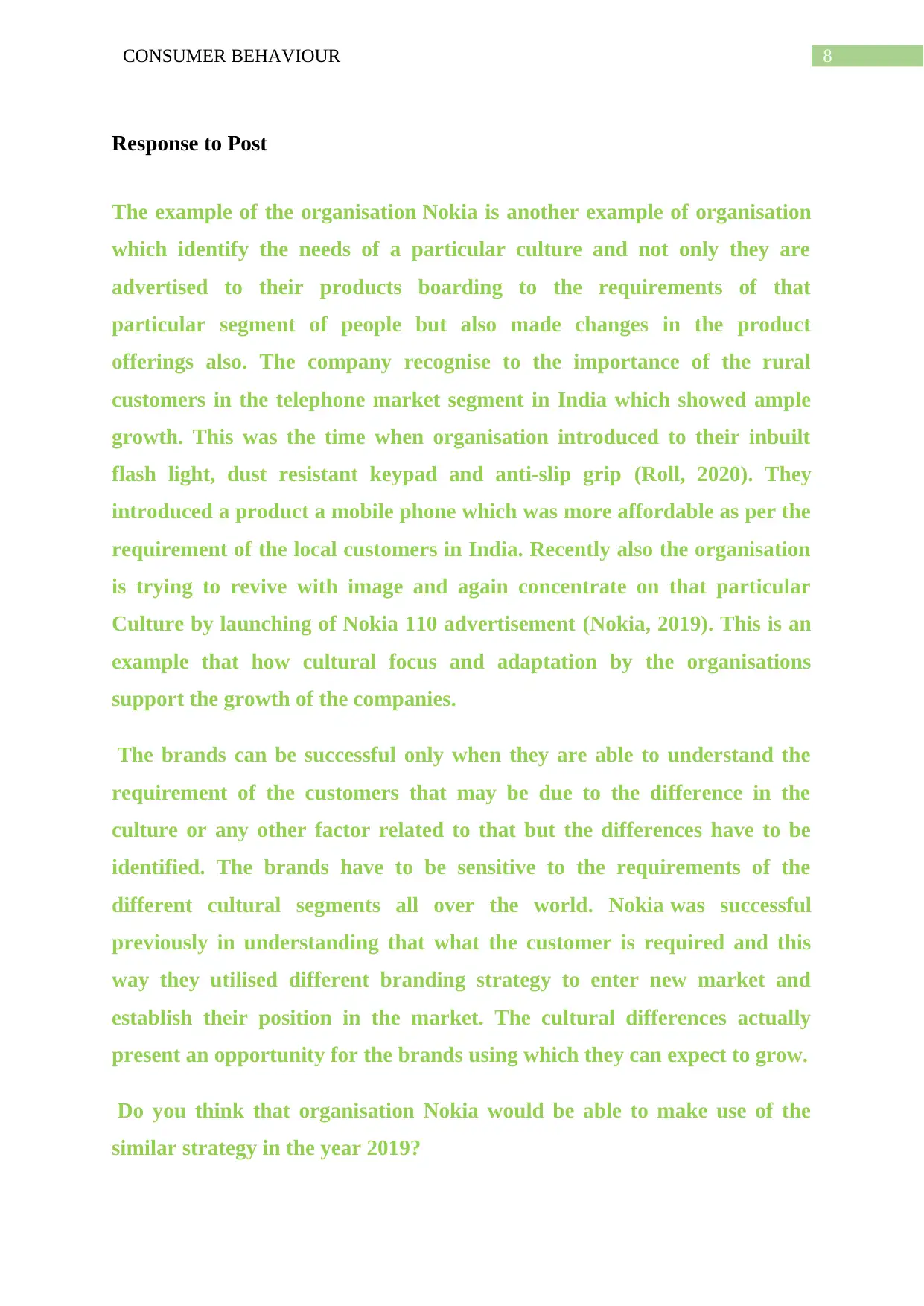
8CONSUMER BEHAVIOUR
Response to Post
The example of the organisation Nokia is another example of organisation
which identify the needs of a particular culture and not only they are
advertised to their products boarding to the requirements of that
particular segment of people but also made changes in the product
offerings also. The company recognise to the importance of the rural
customers in the telephone market segment in India which showed ample
growth. This was the time when organisation introduced to their inbuilt
flash light, dust resistant keypad and anti-slip grip (Roll, 2020). They
introduced a product a mobile phone which was more affordable as per the
requirement of the local customers in India. Recently also the organisation
is trying to revive with image and again concentrate on that particular
Culture by launching of Nokia 110 advertisement (Nokia, 2019). This is an
example that how cultural focus and adaptation by the organisations
support the growth of the companies.
The brands can be successful only when they are able to understand the
requirement of the customers that may be due to the difference in the
culture or any other factor related to that but the differences have to be
identified. The brands have to be sensitive to the requirements of the
different cultural segments all over the world. Nokia was successful
previously in understanding that what the customer is required and this
way they utilised different branding strategy to enter new market and
establish their position in the market. The cultural differences actually
present an opportunity for the brands using which they can expect to grow.
Do you think that organisation Nokia would be able to make use of the
similar strategy in the year 2019?
Response to Post
The example of the organisation Nokia is another example of organisation
which identify the needs of a particular culture and not only they are
advertised to their products boarding to the requirements of that
particular segment of people but also made changes in the product
offerings also. The company recognise to the importance of the rural
customers in the telephone market segment in India which showed ample
growth. This was the time when organisation introduced to their inbuilt
flash light, dust resistant keypad and anti-slip grip (Roll, 2020). They
introduced a product a mobile phone which was more affordable as per the
requirement of the local customers in India. Recently also the organisation
is trying to revive with image and again concentrate on that particular
Culture by launching of Nokia 110 advertisement (Nokia, 2019). This is an
example that how cultural focus and adaptation by the organisations
support the growth of the companies.
The brands can be successful only when they are able to understand the
requirement of the customers that may be due to the difference in the
culture or any other factor related to that but the differences have to be
identified. The brands have to be sensitive to the requirements of the
different cultural segments all over the world. Nokia was successful
previously in understanding that what the customer is required and this
way they utilised different branding strategy to enter new market and
establish their position in the market. The cultural differences actually
present an opportunity for the brands using which they can expect to grow.
Do you think that organisation Nokia would be able to make use of the
similar strategy in the year 2019?
⊘ This is a preview!⊘
Do you want full access?
Subscribe today to unlock all pages.

Trusted by 1+ million students worldwide
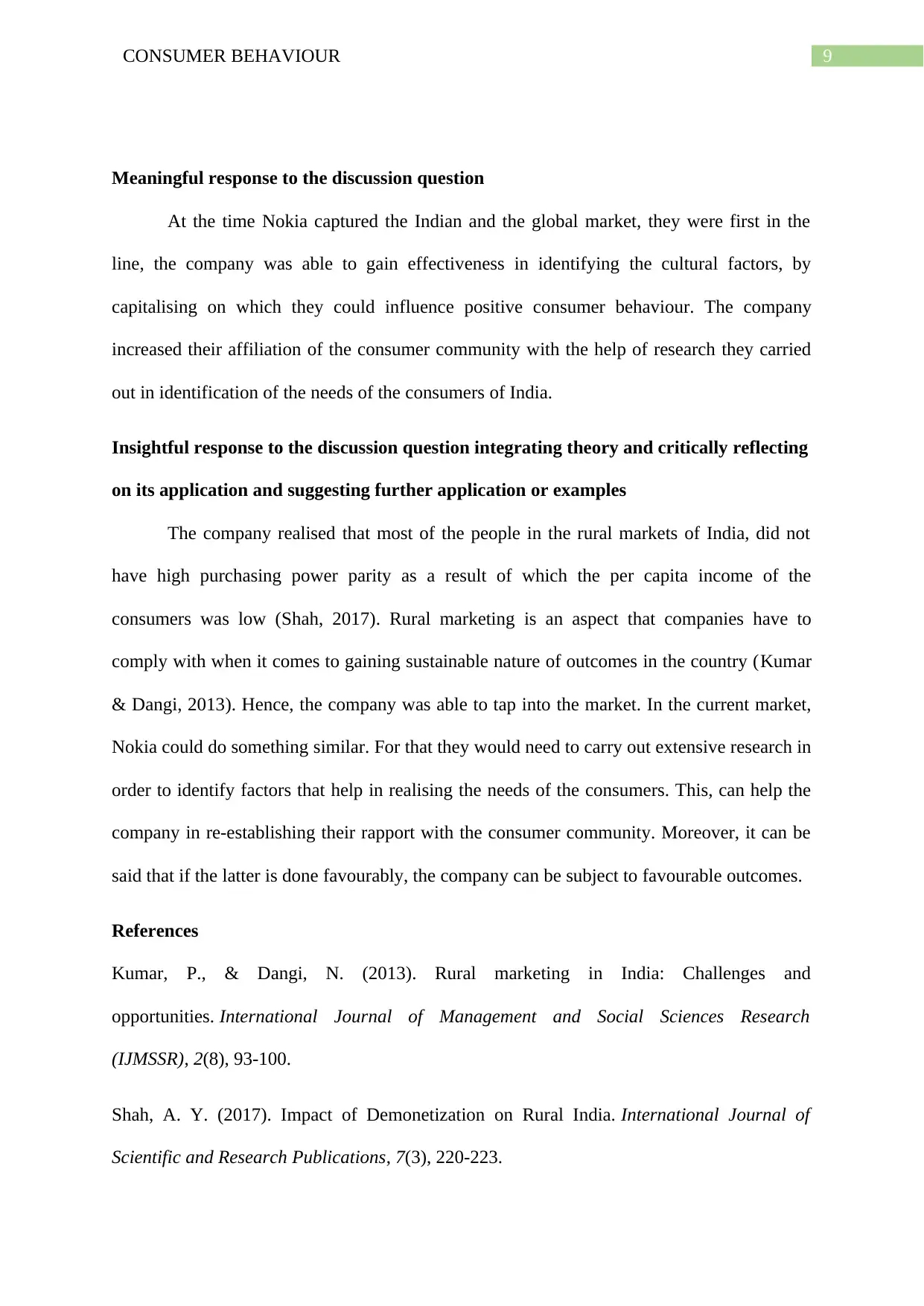
9CONSUMER BEHAVIOUR
Meaningful response to the discussion question
At the time Nokia captured the Indian and the global market, they were first in the
line, the company was able to gain effectiveness in identifying the cultural factors, by
capitalising on which they could influence positive consumer behaviour. The company
increased their affiliation of the consumer community with the help of research they carried
out in identification of the needs of the consumers of India.
Insightful response to the discussion question integrating theory and critically reflecting
on its application and suggesting further application or examples
The company realised that most of the people in the rural markets of India, did not
have high purchasing power parity as a result of which the per capita income of the
consumers was low (Shah, 2017). Rural marketing is an aspect that companies have to
comply with when it comes to gaining sustainable nature of outcomes in the country (Kumar
& Dangi, 2013). Hence, the company was able to tap into the market. In the current market,
Nokia could do something similar. For that they would need to carry out extensive research in
order to identify factors that help in realising the needs of the consumers. This, can help the
company in re-establishing their rapport with the consumer community. Moreover, it can be
said that if the latter is done favourably, the company can be subject to favourable outcomes.
References
Kumar, P., & Dangi, N. (2013). Rural marketing in India: Challenges and
opportunities. International Journal of Management and Social Sciences Research
(IJMSSR), 2(8), 93-100.
Shah, A. Y. (2017). Impact of Demonetization on Rural India. International Journal of
Scientific and Research Publications, 7(3), 220-223.
Meaningful response to the discussion question
At the time Nokia captured the Indian and the global market, they were first in the
line, the company was able to gain effectiveness in identifying the cultural factors, by
capitalising on which they could influence positive consumer behaviour. The company
increased their affiliation of the consumer community with the help of research they carried
out in identification of the needs of the consumers of India.
Insightful response to the discussion question integrating theory and critically reflecting
on its application and suggesting further application or examples
The company realised that most of the people in the rural markets of India, did not
have high purchasing power parity as a result of which the per capita income of the
consumers was low (Shah, 2017). Rural marketing is an aspect that companies have to
comply with when it comes to gaining sustainable nature of outcomes in the country (Kumar
& Dangi, 2013). Hence, the company was able to tap into the market. In the current market,
Nokia could do something similar. For that they would need to carry out extensive research in
order to identify factors that help in realising the needs of the consumers. This, can help the
company in re-establishing their rapport with the consumer community. Moreover, it can be
said that if the latter is done favourably, the company can be subject to favourable outcomes.
References
Kumar, P., & Dangi, N. (2013). Rural marketing in India: Challenges and
opportunities. International Journal of Management and Social Sciences Research
(IJMSSR), 2(8), 93-100.
Shah, A. Y. (2017). Impact of Demonetization on Rural India. International Journal of
Scientific and Research Publications, 7(3), 220-223.
Paraphrase This Document
Need a fresh take? Get an instant paraphrase of this document with our AI Paraphraser
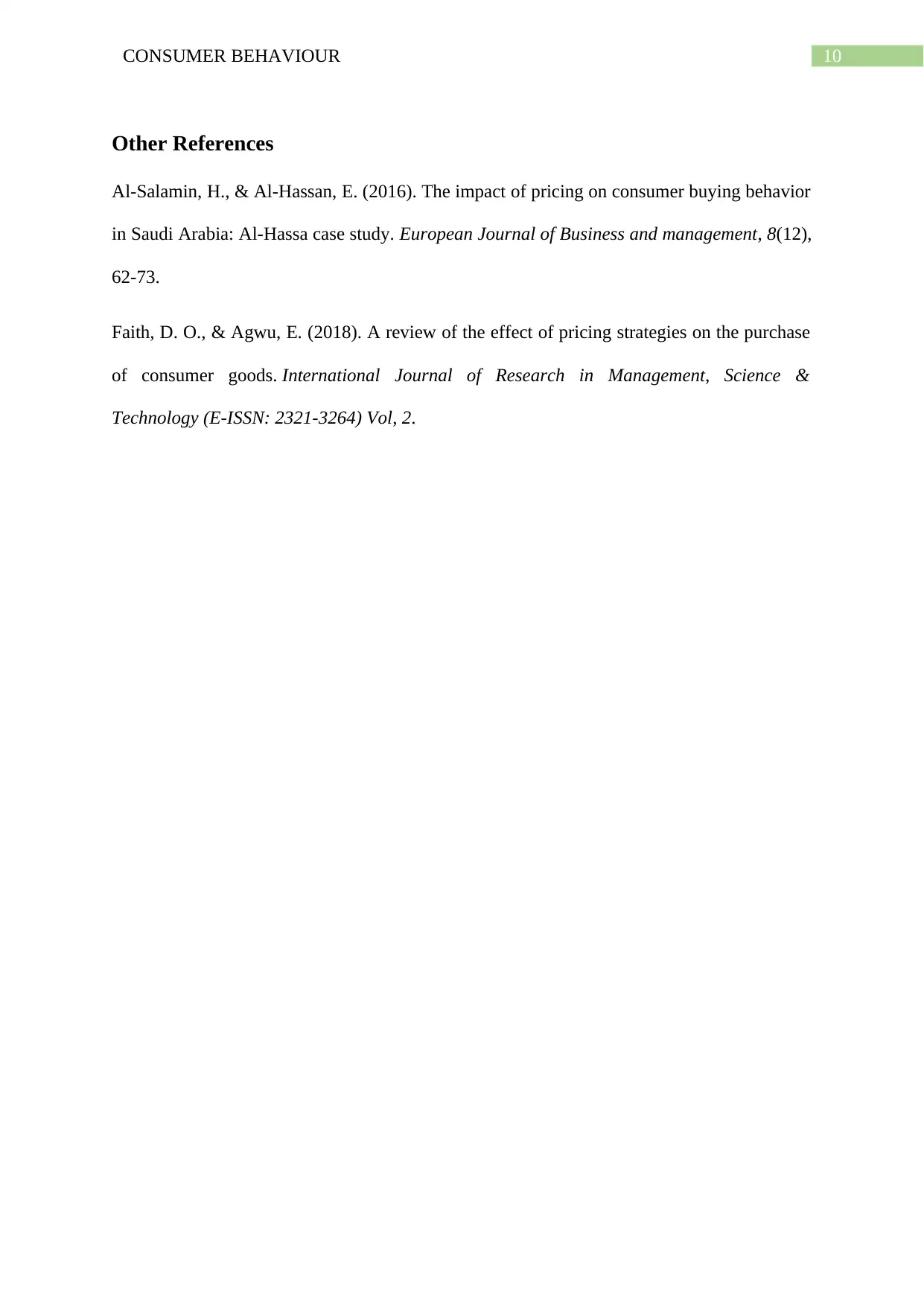
10CONSUMER BEHAVIOUR
Other References
Al-Salamin, H., & Al-Hassan, E. (2016). The impact of pricing on consumer buying behavior
in Saudi Arabia: Al-Hassa case study. European Journal of Business and management, 8(12),
62-73.
Faith, D. O., & Agwu, E. (2018). A review of the effect of pricing strategies on the purchase
of consumer goods. International Journal of Research in Management, Science &
Technology (E-ISSN: 2321-3264) Vol, 2.
Other References
Al-Salamin, H., & Al-Hassan, E. (2016). The impact of pricing on consumer buying behavior
in Saudi Arabia: Al-Hassa case study. European Journal of Business and management, 8(12),
62-73.
Faith, D. O., & Agwu, E. (2018). A review of the effect of pricing strategies on the purchase
of consumer goods. International Journal of Research in Management, Science &
Technology (E-ISSN: 2321-3264) Vol, 2.
1 out of 11
Your All-in-One AI-Powered Toolkit for Academic Success.
+13062052269
info@desklib.com
Available 24*7 on WhatsApp / Email
![[object Object]](/_next/static/media/star-bottom.7253800d.svg)
Unlock your academic potential
Copyright © 2020–2025 A2Z Services. All Rights Reserved. Developed and managed by ZUCOL.